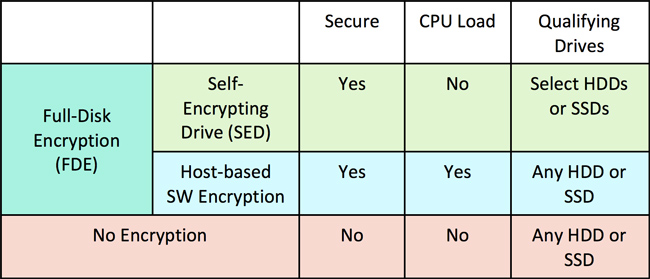Not likely. But you might think that solving your computer data security problems is very well possible when someone tells you that TCG Opal is the key. According to its website, The Trusted Computing Group (TCG) is a not-for-profit organization formed to develop, define and promote open, vendor-neutral, global industry standards, supportive of a hardware-based root of trust, for interoperable trusted computing platforms.
That might take a bit to digest, but think about TCG as a group of companies creating standards to simplify deployment and increase adoption of data security. The consortium has two better known specifications called TCG Enterprise and TCG Opal.
Sorting through the alphabet soup of data security
Our SED with TCG Opal provides FDE. While this might look like a spoonful of alphabet soup, it is music to the ears of a corporate IT manager. Let me break it down for those who just hear fingernails on the chalkboard. A self-encrypting drive (SED) is one that embeds a hardware-based encryption engine in the storage device. One chief benefit is that the hardware engine performs the encryption, preserving full performance of the host CPU. An SED can be a hard disk drive (HDD) or a solid state drive (SSD). True, traditional software encryption can secure data going to the storage device, but it consumes precious host CPU bandwidth. The related term, full drive encryption (FDE), is used to describe any drive (HDD or SSD) that stores data in an encrypted form. This can be through either software-based (host CPU) or hardware-based (an SED) encryption.

Most people would assume that if their work laptop were lost or stolen, they would suffer only some lost productivity for a short time and about $1,500 in hardware costs. However, a study by Intel and the Ponemon Institute found that the cost of a lost laptop totaled nearly $50,000 when you account for lost IP, legal costs, customer notifications, lost business, harm to reputation, and damages associated with compromising confidential customer information. When the data stored on the laptop is encrypted, this cost is reduced by nearly $20,000. This difference certainly supports the need for better security for these mobile platforms.
When considering a security solution for this valuable data, you have to decide between a hardware-based SED and a host-based software solution. The primary problem with software solutions is they require the host CPU to do all of the encryption. This detracts from the CPUs core computing work, leaving users with a slower computer or forcing them to pay for greater CPU performance. Another drawback of many software encryption solutions is that they can be turned off by the computer user, leaving data in the clear and vulnerable. Since hardware-based encryption is native to the HDD or SSD, it cannot be disabled by the end user.
In April 2013, Intel and a few other storage companies worked with the Ponemon Institute to better understand the value of hardware-based encryption. You can read about the details in the study here, but the quick summary is that hardware-based encryption solutions can offer a 75% total cost savings over software-based solutions, on average.
When is this available?
The Computex Taipei 2013 show announced availability of a firmware update for SandForce controllers that adds support for TCG Opal. The SandForce product demonstrations featured TCG Opal using self-encrypting SSDs provided by SandForce Driven member companies, including Kingston, A-DATA, Avant and Edge. (Contact SSD manufacturers directly for product availability.)








Leave A Comment